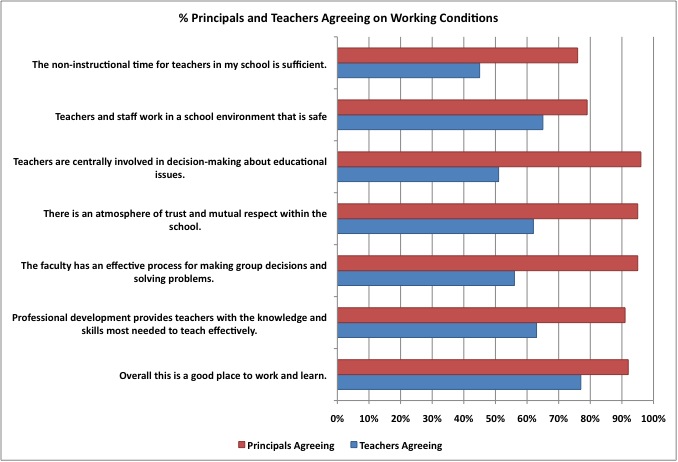How differently do principals and teachers view working condition issues in their schools?
Why is this question important? Evidence suggests that school leadership is a key variable in teacher working conditions, student learning conditions, and school performance. School principals are the critical component of school leadership. The degree to which teachers and principals agree in their assessment of working conditions has the potential to have a significant impact on the success of school improvement.
See further discussion below.

Source: Teacher Working Conditions Are Student Learning Conditions: A Report on the 2006 North Carolina Teacher Working Conditions Survey
Results: The data show a wide disparity between principal and teacher assessments of their schools’ leadership on a range of leadership issues, averaging a difference of 40%.
Implications: Progress on school leadership issues is critical in improving school climates. Progress will be impeded if there is not agreement on leadership issues.
Author(s): Eric Hirsch, New Teacher Center, Keri Church, LEARN INC, et. al.
Publisher: New Teacher Center, University of California, Santa Cruz 2009
Study Description: North Carolina’s Professional Teaching Standards Commission and State Board of Education have conduced Teacher Working Condition Surveys since 2001. The above data represents the responses of over 75,000 North Carolina educators (66%) from a survey completed in 2006. Roughly 1,400 principals responded to the survey. The New Teacher Center analyzed the answers given by principals and teachers on a range of leadership questions. Supporting statistical and research documentation is available at www.ncteachingconditions.org.
Citation:
Hirsch, E., & Emerick, S. (with Church, K. & Fuller, E.). (2007). Teacher working conditions are student learning conditions: A report on the 2006 North Carolina teacher working conditions survey. Chapel Hill, NC: Center for Teaching Quality. Retrieved September 16, 2009, from https://files.eric.ed.gov/fulltext/ED498770.pdf
